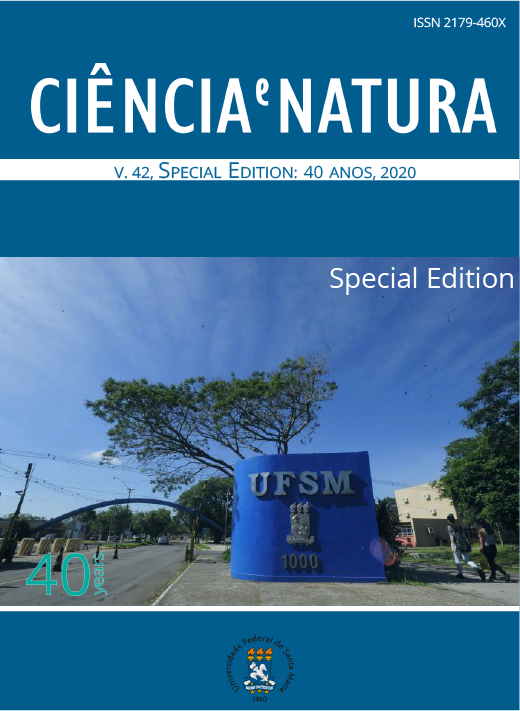Water table fluctuation method to estimate the recharge of the free aquifer in the Guariroba river basin, Campo Grande – MS
DOI:
https://doi.org/10.5902/2179460X41465Palavras-chave:
Bauru Aquifer System Recharge, groundwater table fluctuation, watershedResumo
The Guariroba river basin was decreed as an Environmental Protection Area (EPA), and with a surface of 360 km² it is of great importance to the municipality of Campo Grande because it supports almost half of the water supply system of the latter. The surface of the basin is predominantly covered by Cretaceous sediments of the Caiuá Group, which constitutes the free aquifer known as the Bauru Aquifer System (BAS). Recent studies have confirmed the contribution of the BAS in the maintenance of the base flow of surface drainage. Therefore, the quantification of groundwater recharge (GWR) becomes fundamental. This work used the water table fluctuation (WTF) method, based on variations in the piezometric surface-water measurement, to estimate the GWR of the basin. From Mar 2015–Feb 2017, monthly variations of the static level were registered in 13 tubular wells located in the Guariroba EPA. Considering a 1480 mm annual precipitation, the estimated average GWR was 356 mm⋅year–1, varying between 210–694 mm⋅year–1. Despite considering a lower value of the effective porosity parameter (Sy = 0.1) than the one suggested for the BAS, the estimated average GWR-to-precipitation ratio (24%) was more than double that the one adopted by the state environmental agency (10%).
Downloads
Referências
CAMPO GRANDE. Plano de manejo da Área de Proteção Ambiental dos mananciais do córrego Guariroba (APA) do Guariroba. Campo Grande, 2008. 158 p.
CASADEI JM. Vulnerabilidade do aquífero livre na bacia hidrográfica do córrego Guariroba – Campo Grande, MS, em Programa PGTA [dissertation] Campo Grande: UFMS; 2016. 86 p.
CAVAZZANA GH. Relação entre a água superficial e a água subterrânea da Área de Proteção Ambiental do Guariroba, Estado de Mato Grosso do Sul, Brasil [PhD thesis]. Campo Grande: Programa PGTA/UFMS; 2018. 137 p.
CAVAZZANA GH, LASTORIA G, GABAS SG. Surface-groundwater interaction in unconfined sedimentary aquifer system in the Brazil’s tropical wet region. Brazilian Journal of Water Resources 2019;24(8):2–15.
CHUNG IM, SOPHOCLEOUS MA, MITIKU DB, KIM NW. Estimating groundwater recharge in the humid and semi-arid African regions: review. Geosciences Journal 2016;20(5):731–744.
COMPANHIA DE PESQUISA DE RECURSOS MINERAIS-CPRM- SERVIÇO GEOLÓGICO DO BRASIL. Mapa Geológico do Estado de Mato Grosso do Sul (escala 1:1.000.000). São Paulo (Brazil): 2006.
LASTORIA G, GABAS SG, CAVAZZANA GH, CASADEI JM, AZOIA DE SOUZA T. Potencialidade dos recursos hídricos na bacia do córrego Guariroba, município de Campo Grande-MS. In: Geologia ambiental: tecnologias para o desenvolvimento sustentável. Org. por Cardozo, EL. Atena Editora, Ponta Grossa–PR; 2017. p. 204–213.
LASTORIA G, CAVAZZANA GH, OLIVA A, GABAS SG, CHANG HK. Contribuição da geofísica para a hidrogeologia da APA Guariroba, município de Campo Grande-MS. In: Anais do XX Congresso Brasileiro Águas Subterrâneas; nov./2018; Campinas-SP, Brazil. p. 38–41.
MANCUSO MA, CAMPOS JE. Aquífero Bauru. In: Mapa de águas subterrâneas do Estado de São Paulo (escala 1:1.000.000): nota explicativa. Coord. Rocha, G. DAEE, IPT, CPRM, São Paulo, 2005, p. 32–38.
SECRETARIA DE ESTADO DE MEIO AMBIENTE DO PLANEJAMENTO DA CIÊNCIA E TECNOLOGIA E INSTITUTO DE MEIO AMBIENTE DE MATO GROSSO DO SUL-SEMAC. Plano Estadual de Recursos Hídricos de Mato Grosso do Sul. Campo Grande- MS. Editora UEMS; 2010. 116 p.
TAHAL CONSULTING ENGINEERS LTD; EMPRESA DE SANEAMENTO DE MATO GROSSO DO SUL S.A.-SANESUL Estudos Hidrogeológicos de Mato Grosso do Sul.: Relatório Final. Campo Grande-MS, 1998, v.I, 398p.
Downloads
Publicado
Como Citar
Edição
Seção
Licença
Para acessar a DECLARAÇÃO DE ORIGINALIDADE E EXCLUSIVIDADE E CESSÃO DE DIREITOS AUTORAIS clique aqui.
Diretrizes Éticas para Publicação de Revistas
A revista Ciência e Natura está empenhada em garantir a ética na publicação e na qualidade dos artigos.
A conformidade com padrões de comportamento ético é, portanto, esperada de todas as partes envolvidas: Autores, Editores e Revisores.
Em particular,
Autores: Os Autores devem apresentar uma discussão objetiva sobre a importância do trabalho de pesquisa, bem como detalhes e referências suficientes para permitir que outros reproduzam as experiências. Declarações fraudulentas ou intencionalmente incorretas constituem comportamento antiético e são inaceitáveis. Artigos de Revisão também devem ser objetivos, abrangentes e relatos precisos do estado da arte. Os Autores devem assegurar que seu trabalho é uma obra totalmente original, e se o trabalho e / ou palavras de outros têm sido utilizadas, isso tem sido devidamente reconhecido. O plágio em todas as suas formas constitui um comportamento publicitário não ético e é inaceitável. Submeter o mesmo manuscrito a mais de um jornal simultaneamente constitui um comportamento publicitário não ético e é inaceitável. Os Autores não devem submeter artigos que descrevam essencialmente a mesma pesquisa a mais de uma revista. O Autor correspondente deve garantir que haja um consenso total de todos os Co-autores na aprovação da versão final do artigo e sua submissão para publicação.
Editores: Os Editores devem avaliar manuscritos exclusivamente com base no seu mérito acadêmico. Um Editor não deve usar informações não publicadas na própria pesquisa do Editor sem o consentimento expresso por escrito do Autor. Os Editores devem tomar medidas de resposta razoável quando tiverem sido apresentadas queixas éticas relativas a um manuscrito submetido ou publicado.
Revisores: Todos os manuscritos recebidos para revisão devem ser tratados como documentos confidenciais. As informações ou ideias privilegiadas obtidas através da análise por pares devem ser mantidas confidenciais e não utilizadas para vantagens pessoais. As revisões devem ser conduzidas objetivamente e as observações devem ser formuladas claramente com argumentos de apoio, de modo que os Autores possam usá-los para melhorar o artigo. Qualquer Revisor selecionado que se sinta desqualificado para rever a pesquisa relatada em um manuscrito ou sabe que sua rápida revisão será impossível deve notificar o Editor e desculpar-se do processo de revisão. Os Revisores não devem considerar manuscritos nos quais tenham conflitos de interesse resultantes de relacionamentos ou conexões competitivas, colaborativas ou outras conexões com qualquer dos autores, empresas ou instituições conectadas aos documentos.






